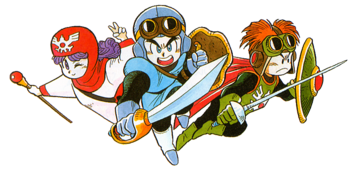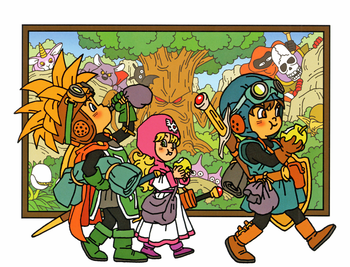Dragon Quest II: Luminaries of the Legendary Line
| Main series games | |
|---|---|
| Luminaries of the Legendary Line | |
 
| |
| Developer(s) | Chunsoft |
| Publisher(s) | Enix |
| Designer(s) | Yūji Horii |
| Artist(s) | Akira Toriyama |
| Composer(s) | Koichi Sugiyama |
| Series | Dragon Quest |
| Platform(s) | NES/Famicom, Super Famicom, GBC, Wii (hybrid cartridge), MSX, SFC, Cell phone, Android & iOS, Playstation 4, Nintendo 3DS, Nintendo Switch |
| Release date(s) | JP January 26, 1987 NA December 1990 |
| Genre(s) | Console role-playing game |
| Mode(s) | Single player |
| Media | 2-megabit NES cartridge Floppy disk (MSX) GBC/SFC cartridges |
Dragon Quest II (ドラゴンクエストII 悪霊の神々 Doragon Kuesuto Tsū Akuryo no Kamigami, literally meaning; "Pantheon of Evil Spirits") originally known as: Dragon Warrior II, is a role-playing game and sequel to the original Dragon Quest. It was initially released for the Famicom in Japan on January 26, 1987. It would later be released in North America in 1990 and has been remade several times on different platforms. Currently, it is known as Dragon Quest II: Luminaries of the Legendary Line.
Series additions
Dragon Quest II offers a much wider array of spells and items, as well as a much larger world (256 by 256 tiles instead of 100 by 100) than its predecessor. After battle status ailments have been introduced as well, embodied in the new Bubble slime foe. Due to the limited size of the NES/Famicom's cartridge ROM space at the time, the detailed battle backgrounds from the first game were replaced with a black background to make room for the increased number of monster sprites.
Multiple characters
Dragon Quest II is noted for greatly expanding the game play from the previous title, such as featuring multiple heroes and enemies in a battle. Each Luminary has a well defined range of abilities and weaknesses that would codify later characters and vocations, and the menagerie of monster encounters would follow suit. Party dynamics, extended strategies, and shuffling through equipment to better suit specific encounters all began with II.
Augmentative and debilitating spells
Where as battle spells in the first game were limited to disabling foes and inflicting/restoring damage, the sequel introduced the concept of influencing a character or monster's stats through the use of Kabuff and Kasap. The theme of spending a turn buffing characters and weakening monsters would be greatly expanded upon in future titles, quickly becoming just as important as combating monsters directly.
Transportation
The humble Ship attained in Rippleport set the standard for expanding the reach of the player at the midway point of a game.
Teleportals were introduced to allow for faster traveling between areas, and to serve as early previews of distant lands to highlight the greater scope of the game compared to it's predecessor. They have become a staple of the series ever since, appearing in every title as both convenience features and as elements of the story.
Tombola
Gambling also made its first appearance in the series, with several towns featuring medieval slot machines called the tombola for the player to utilize at the cost of a tombola ticket given by merchants. Breakable keys have been removed, replaced by the Silver Key, Golden Key, and Thief's Key. Churches have now been given actual function rather than cosmetic purpose, with priests reviving fallen party members and removing various ailments for a fee.
Multiple save locations
The game provides multiple locations for players to save their progress. It also allows deletion and the moving of saved games. To save, find a king, minister, or wise man and talk to them to initiate the process--this save area will also be the Zoom location in most versions. As in the first game, the original Japanese version had a password system (or "Spell of Restoration") instead a battery backup (or "Imperial Scrolls of Honor").
Version Differences
See: Dragon Quest I & II for more detailed changes and improvements.
Since its original release on the Famicom and Nintendo Entertainment System four remakes have appeared, with the first being on the Super Famicom, second the on Gameboy Color, third Cell phones in Japan, and the most current being an iOS/Android release in the Japanese app store on June 26th, 2014 before being internationally released. All the remakes feature updated graphics and music as well as a few other new features, such as quick-saving on the world map, animated battles, and the automatic redirecting of attacks that target defeated monsters. Starting with the cell phone version, all three descendants of Erdrick are capable of attaining level 50, with the two magic user's stat growth and exp requirements being adjusted accordingly. Additionally, the Zoom spell was made consistent with later games by letting the player choose a select list of destinations to rather than the last place saved.
Due to spacial constraints of the Gameboy and Gameboy color's screen, the english release of Dragon Warrior 1+2 in 2000 reverted the localized names of Erdrick, Gwaelin, and others to a closer approximation of their Japanese counterparts. These changes would be undone by Plus-Alpha in 2010 with their localization of Dragon Quest IX, which elected to retain the NES names as a surprise for older fans. As of the 2014 iOS/Android re-release, while several of the names of characters and locations have retained their NES designations (or very slight edits of such, like Midenhall instead of Middenhall), other characters and locations have elected for new translations that are closer to the meanings and puns of the original Japanese version. In addition, monsters, spells, and items have been updated to their modern naming conventions.
Characters
Prince of Midenhall
- See main article: Prince of Midenhall
The heir of the Kingdom of Midenhall is the classic warrior of the three Luminaries, with the most impressive physical stats. He can equip all weapons and armour in the game, though he has no magic ability (he is the only protagonist in the series to lack magical aptitude). This is the character the player starts out with in the castle of Midenhall, and his name is directly selected by the player.
Prince of Cannock
- See main article: Prince of Cannock
The prince of Cannock is closer to his ancestor than the other Luminaries. He cannot use as wide a variety of weapons and armor as the prince of Midenhall but compensates for this with the ability with a unique assortment of spells. However, it should be noted that his magic is not as powerful as that wielded by the princess of Moonbrooke. Despite this, he can, like his cousin, equip the Erdrick's sword. This character is hard to track down in the beginning of the game, but he will grow to be a great ally. In earlier releases, his name is generated at random based on the name of the prince of Midenhall, although there is a cheat code to alter his name. As of the Cell phone release, his name is offered initially via a random generator when the Hero departs from Midenhall, but the player can also decide to give the Prince of Cannock a name of the player's choosing.
Princess of Moonbrooke
- See main article: Princess of Moonbrooke
The princess of Moonbrooke is the archetypal sorceress of the three Luminaries. Her armour and weapon selections are slim, but are incredibly potent. She shares some of the prince of Cannock's magic, but the bulk of her spells are exclusive to her. She is the first of the three main characters the player will see, shown being assaulted with her father in the game's cinematic intro. After this she will has been cursed and needs to be freed before she will be able to join her cousins. In earlier releases, her name is generated at random based on the name of the prince of Midenhall, although there is a cheat code to alter her name. As of the Cell phone release, her name is offered initially via a random generator when the Hero departs from Midenhall, but the player can also decide to give the Princess of Moonbrooke a name of the player's choosing.
Hargon
- See main article: Hargon
Hargon is the wicked occultist that attacked Moonbrooke, cursed its princess, and threatened to destroy the world by summoning the gods of evil. His defeat is the goal of the three heroes.
Plot
Legacy

Dragon Quest II is widely recognized for improving upon the shortcomings of its predecessor, increasing the depth of battle and exploration considerably. Series director Yuji Horii's writing is also seen as improving during the development of the game, no longer relying solely on fairy-tale archetypes to constitute the setting and characters.
Ports
- Dragon Quest II had a port for the MSX platform in Japan.
- Dragon Quest II was released in North America, under the name Dragon Warrior II, on the Nintendo Entertainment System in December of 1990.
Remakes
- Dragon Quest II was remade and combined with Dragon Quest. It was released as Dragon Quest I & II on the Super Famicom and Game Boy Color in the 90's, on Cell phones in the early millennium, and on android and ios smart phones in June of 2014.
Trivia
- A smaller, simplified version of the world of Dragon Quest is included on the world map in Dragon Quest II.
- Dragon Quest II was the first game in the series to feature pits and tower balconies from which the party can fall. (As always, they take no damage from this.)
- The MSX version of the game contained a special scene involving the "Dangerous Swimsuit" and the Princess of Moonbrooke. This was removed by the time the game made it outside of Japan, due to Nintendo of America's strict censorship policies and the objectively poor quality of the image in question.
- This "Dangerous Swimsuit" scene was referenced in the 2005 PC title La-Mulana, which was made to pay tribute to the MSX and its library of games. The main character, Lemeza Kosugi, receives the "Provocative Bathing Suit" from the NPC Dracuets at the end of the game's bonus dungeon, the Hell Temple, with a graphic of him in the Bathing Suit flashing on screen. The reference was maintained in the 2011 remake.
Soundtrack
Koichi Sugiyama composed the music and directed all the associated spin-offs. Dragon Quest II's symphonic suite was bundled with Dragon Quest I's symphonic suite and a disc of original compositions as Dragon Quest in Concert. Here is the track listing of the Dragon Quest II portion of that release:
- Dragon Quest March (ドラゴンクエストマーチ/Dragon Quest March) (1:39)
- Only Lonely Boy (Love Song 探して/Looking for the Love Song) (2:42)
- Pastoral ~ Catastrophe (3:21)
- Château (王城/Royal Castle) (3:03)
- Town (街の賑わい/Bustle of the Town) (3:30)
- Fright in Dungeon ~ Devil's Town (恐怖の地下洞~魔の塔/Fear Dungeon ~ Devil's Town) (4:02)
- Requiem (レクイエム/Requiem) (2:09)
- Endless World (遥かなる旅路~広野を行く~果てしなき世界/Distant Journey ~ Going in Plain ~ Endless World) (5:43)
- Beyond the Waves (海原を行く/Going on the Sea) (2:13)
- Deathfight ~ Dead or Alive (戦い~死を賭して/Fighting ~ Risking Death) (3:56)
- My Road, My Journey (この道わが旅/My journey is This Road) (4:10)












